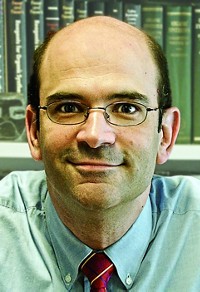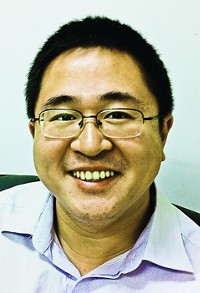Advertisement
Grab your lab coat. Let's get started
Welcome!
Welcome!
Create an account below to get 6 C&EN articles per month, receive newsletters and more - all free.
It seems this is your first time logging in online. Please enter the following information to continue.
As an ACS member you automatically get access to this site. All we need is few more details to create your reading experience.
Not you? Sign in with a different account.
Not you? Sign in with a different account.
ERROR 1
ERROR 1
ERROR 2
ERROR 2
ERROR 2
ERROR 2
ERROR 2
Password and Confirm password must match.
If you have an ACS member number, please enter it here so we can link this account to your membership. (optional)
ERROR 2
ACS values your privacy. By submitting your information, you are gaining access to C&EN and subscribing to our weekly newsletter. We use the information you provide to make your reading experience better, and we will never sell your data to third party members.
Synthesis
David Sherman: Arthur C. Cope Scholar Awardee
Recipients are honored for contributions of major significance to chemistry
by Susan J. Ainsworth
March 9, 2009
| A version of this story appeared in
Volume 87, Issue 10
"Moving from the organic chemistry lab of Gilbert Stork at Columbia University to a postdoctoral fellowship in molecular biology was quite unusual in 1982," admits David H. Sherman, 51, the Hans W. Vahlteich Professor of Medicinal Chemistry in the College of Pharmacy at the University of Michigan, Ann Arbor.
However, Sherman's penchant for forging new paths has served him well. The bacterial genetics training he gained as a National Institutes of Health postdoctoral fellow at Massachusetts Institute of Technology allowed him to pursue his passion for investigating the genetic and biochemical basis of microbial biosynthesis of natural products. While serving in various academic and industrial positions over the past 18 years, Sherman has conducted groundbreaking research in this area, studying terrestrial and marine organisms such as actinomycetes, cyanobacteria, and fungi.
Sherman is "fearless in his ability to approach problems from a diverse viewpoint, and his multidisciplinary efforts typically coalesce into a rigorous and elegant evaluation of exciting research problems at the forefront of organic chemistry," according to John Montgomery, a fellow chemistry professor at the University of Michigan.
Sherman developed a love for natural products as an undergraduate working with Phil Crews at the University of California, Santa Cruz. As his Ph.D. adviser, Stork then instilled "a wonder and a curiosity for molecular architecture," he says. "Those influences provided the foundation for my long-term research interests."
Along with a team with broad expertise in enzymology, molecular genetics, metabolic engineering, and organic synthesis, Sherman has focused on characterization of genes and enzymes involved in natural product assembly, tailoring, and mechanisms of antibiotic-resistance, Montgomery notes.
In particular, Sherman's study of the methymycin/pikromycin biosynthetic system "highlights the range of investigations that his laboratory has pursued over a multiyear period to provide insights into polyketide chain elongation, processing, termination, cyclization, and tailoring," Montgomery adds. Initially, Sherman was drawn to this macrolide pathway because of its unique ability to produce both 12- and 14-membered macrolactones as well as its unusual number of hydroxylated forms.
More recently, Sherman and his group developed an efficient way to assemble cryptophycin anticancer drugs by using a combination of chemical and enzymatic methods. As a final step, they employ the CrpE cytochrome P450 to stereospecifically install the β-epoxide that is key to the cryptophycins' biological activity. "This solved a long-standing problem that we hope will provide greater, more affordable access to these important molecules," Sherman says.
Sherman is working with Ann Arbor-based Alluvium Biosciences to commercialize the method for creating new cryptophycin analogs with enhanced anticancer properties.
Sherman has also completed detailed studies of curacin A biosynthesis from the marine cyanobacterium Lyngbya majuscula. Discovering a new mode of chain initiation in curacin A biosynthesis was particularly gratifying, he says. It involved "a totally unprecedented mechanism and required challenging biochemical, bioanalytical, and structural biology approaches to dissect the details," he says. "However, once it was completed we could sit back and appreciate the beauty of this new process and its widespread application in natural product systems."
For the long-term, Sherman hopes to harness the biochemical tools provided by secondary metabolic pathways to build entirely new natural product core structures with diverse biological activities and other high-value properties.
As a recipient of the Arthur C. Cope Scholar Award, Sherman says he is "especially pleased that ACS has recognized this important field of cross-disciplinary chemical research and the enormous progress that has been made in the field of natural product biosynthesis over the past 20 years."
"It is now clear that synthetic chemistry, along with molecular biology and biochemistry, can be used to decipher the intricate details of assembly and tailoring of complex natural product molecules," he adds. "In turn, these fascinating biosynthetic systems are providing access to novel biochemical processes that can inspire chemists in new ways as they probe new reaction mechanisms and develop strategies for constructing and functionalizing complex organic molecules."





Join the conversation
Contact the reporter
Submit a Letter to the Editor for publication
Engage with us on Twitter